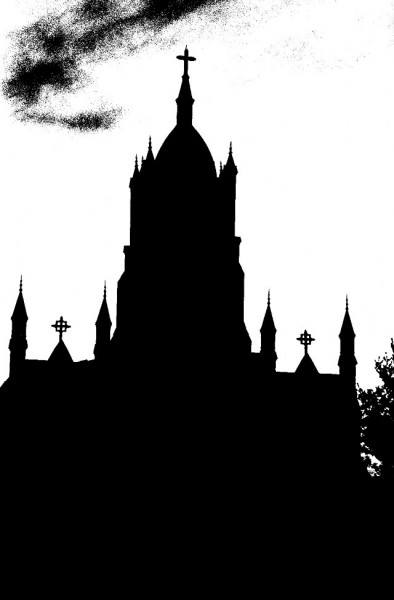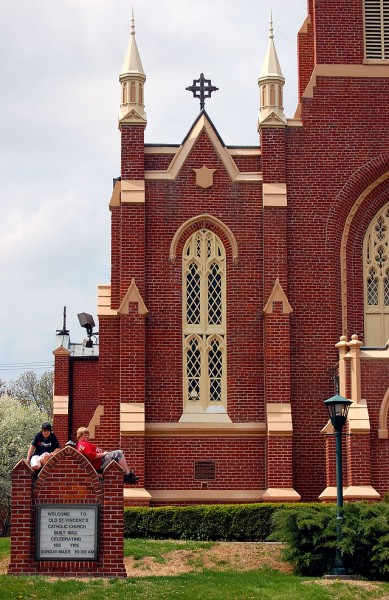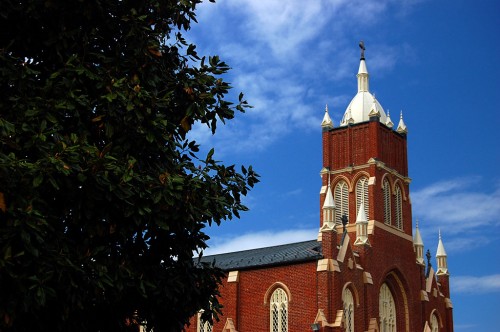 There was a time when I experimented with high contrast photos and silhouettes. It was a fascination that didn’t last long. This church looked familiar, but I wasn’t exactly sure where or what it was.
There was a time when I experimented with high contrast photos and silhouettes. It was a fascination that didn’t last long. This church looked familiar, but I wasn’t exactly sure where or what it was.
Definitely St. Vincent de Paul Catholic Church
 There’s no doubt that it’s St. Vincent de Paul Catholic Church on Main Street across from the Red House as confirmed by this photo I ran in November. There’s no mistaking those squared, open crosses below the steeple.
There’s no doubt that it’s St. Vincent de Paul Catholic Church on Main Street across from the Red House as confirmed by this photo I ran in November. There’s no mistaking those squared, open crosses below the steeple.
How do you make a silhouette?
 Pick the right subject. It has to be something that has a distinctive shape.
Pick the right subject. It has to be something that has a distinctive shape.- It has to have a strong light behind it.
- Underexpose the foreground, intentionally letting it go dark.
- When printing it on paper, pick a high contrast photographic paper. That will cause the blacks to go black and the whites to go white, while eliminating most gray tones. (Does anybody still do darkroom work anymore?)
- When producing it for the screen, do the same thing. Make the whites whiter and the blacks blacker until pure black and pure white are all that are left.

I miss darkroom work, but yes, they still do it at least in part, though it’s now called Photoshop.
I keep wondering what might happen if one big plug were pulled: what would people have to know to record things for posterity? We’ve been so digitally visual for so long.
Say what you want about digital darkrooms you still can’t match Tri-x 400 or Ilford for black and white. Photoshop just fails to deliever B&W.
It is a scary thought that nearly all graphic images and textual images are stored digitally these days. If the few locations where paper documents have been accumulated were destroyed and some electromagnetic event of gigantic proportion were to occur, much of the accumulated knowledge of the modern world would be difficult at best to reproduce. Brings to mind H.G. Wells’ Time Machine…
My former boss, the IT manager, and I were talking about digital archiving one day.
I was saying that so long as I had a candle and a magnifying glass, my silver film photos would be viewable.
“All it would take to wipe out the digital archive would be a someone walking through the computer room with a big magnet.”
Having made my point, I had to concede that it’s easier to keep multiple copies of a digital print in diverse locations. Each print is identical and each print may be duplicated endless times with no degradation in quality.
The biggest problem is reading prior storage media. When was the last time you saw a computer with a 5-1/4 floppy drive? Worse yet, how about those tape backups? Do you have the hardware to read the tapes? How about the software that created the backup?
When I last visited the Cape library, I walked down the stacks and saw book that I had read in high school. They were just as readable today as they were in the mid-60s. Will you be able to say the same about the file you downloaded to your Kindle or other eBook reader.
I’d have to hit a lottery to print all the images I have shot over the years and it would take a library to hold them all. It is a scary thought that they could all be lost though. One crash of my computer several years ago took 40,000 images with it. I was only able to recover a fraction of those.
Did we learn a valuable lesson from that? Backup, backup, backup.
I won’t say that I won’t get wiped out, but here’s some of my precautions:
1. Photos are stored on an external RAID device. That means that there are two drives that are mirrored so that one can fail and the data is safely on the second drive. That’s important because one of mine failed when I was in Cape in the spring. I replaced it and a second one failed when I got back to FL this week. If it hadn’t been for the RAID, I’d have lost everything.
2. The RAID drives are backed up to another external drive with Acronis backup software.
3. I copy the photo files to a third external drive for portable use. If the hurricane had come closer to it, I’d have stored it somewhere else in case our house was hit hard.
It’s not a matter of IF a hard drive will crash. It’s a matter of when.
I was at the big community yard sale in Carbondale, IL yesterday in the parking lot of the SIU Arena. A friend was there selling lots of junk and amongst all the videotapes, toys and old typewriters she had a nearly complete darkroom setup including a couple of enlargers. I seriously doubt that she sold it, but I must admit I was tempted by it a little.
I’ve got everything to set up a darkroom except the chemicals, but I don’t have any desire to do it. I can scan a negative that I would have thought would be unprintable in a conventional darkroom and get detail that is almost invisible.
I miss the sounds and smells of a real darkroom, but not the results.